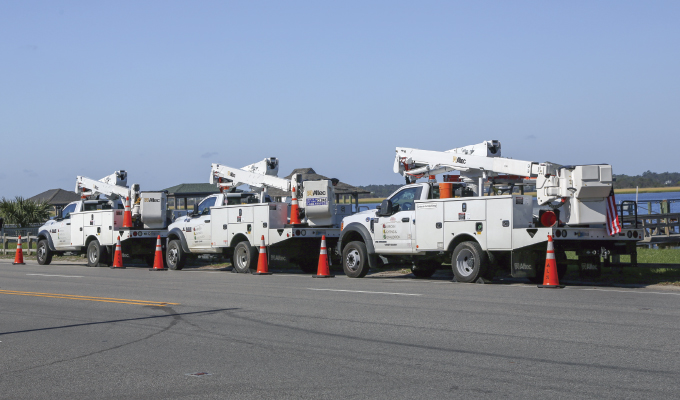As the frequency and severity of natural disasters increases, vocational fleets must modernize how they prioritize safety, uptime, and vehicle health for emergency deployment.
Each year, thousands of hard-working crews take on a nonstop, complicated, hyper-intense effort to help communities return to normalcy after hurricanes, floods, freezes, wildfires, and other natural disasters. During this recovery period, assets are put to work more than usual, and operators are lucky to get a few hours of sleep each day.
But vocational fleets that track asset utilization by whiteboard or other manual processes are leaving money on the table. As tight budgets and recruitment challenges impact more companies in 2024, now is the time to consider implementing technology for smart fleet management. Communities rely on your crew in times of emergency and these technologies equip every fleet asset and jobsite for maximum safety, efficiency, and hard-working uptime. Driving down worksite inefficiencies results in higher profitability and improves reimbursement recovery rates for federal programs and private contracts.
MANAGE FLEET HEALTH
Fleet managers need a way to ensure assets don’t go down in the middle of the work. Too much depends on it.
Justin Brands, Southern California fleet manager for Hot Line Construction, is based in California, where wildfires, high winds, and other disasters affect the state’s utility networks.
“Trees are on fire when we’re down there,” Brands says. “You don’t want to find yourself with a broken-down truck. Uptime is important.”
Hot Line Construction uses a fleet diagnostics and preventative maintenance platform that consolidates jobsite IoT data—including vehicle health, fault codes and location—in a single view. While this maximizes utilization across sites, it also works as an early warning system to prevent unplanned downtime and save thousands of dollars in critical repairs.
Tracking down assets as a mechanic during disaster recovery efforts can be challenging. You know where they showed up in the morning, but even if you can get field location information, knowing the driver’s route is another barrier, especially with fire roads, closed areas and locked gates. Hot Line’s approach is ideal. The crew has a streamlined, comprehensive view of all assets and vehicles across the fleet to know what asset is running an error, its location, and the right parts and tools needed to fix it.
“If you don’t have telematics and something goes down, now you’re renting equipment, trying to get assets on site, and there’s a cost in time and man hours,” Brands says. “If you don’t have the equipment, you might not get the work.”
TRACK ASSET UTILIZATION
When crews are on long-term disaster recovery projects, it’s imperative that they accurately track asset use, mileage, and other criteria for billing and reimbursement. Outdated, manual processes—whiteboards, logbooks and Excel files saved on desktops—risk leaving millions of dollars in FEMA and private contract reimbursements on the table each year.
Manual documentation processes can be so arduous that teams don’t submit the full cost for reimbursement, and if they do, the returns are minimal due to incomplete materials. For companies that work directly with FEMA, a lack of records can result in denial of a substantial portion of reimbursements. These are the fleets that would benefit from smarter solutions that digitize disaster relief tracking and reporting.
Zonar has worked with Idaho-based Kootenai Electric Cooperative since 2014. It’s the largest electric cooperative in Idaho, and part of its role is helping communities recover from disaster-related events. The work includes debris removal, power restoration, and emergency protective measures.
For years, it manually tracked and reported work, relying on operators to manage inspections, logging timecards and pre-flight systems. This approach didn’t provide the visibility the team needed into their fleet so they could recover more of their resources. When it digitized its fleet tracking and reporting processes to meet FEMA reimbursement requirements, it improved reimbursement recovery by nearly 100% over two years.
The team leveraged smart fleet management technology to access data on their crews in FEMA zones, giving them real-time visibility into manpower hours and locations. The crews could enter their pre- and post-trip data, and the new system would complete the process from there. This approach allowed the cooperative to track and re-allocate assets during emergency events, monitor crew efficiency, and quickly complete the rigorous FEMA documentation.
Smart fleet solutions help organizations digitize disaster relief tracking and reporting for greater accuracy and reimbursement.
THE BOTTOM LINE
As the frequency and severity of natural disasters increases, the public and private sector are investing in ways to safeguard critical infrastructure.
The benefit of a smart fleet management solution goes beyond supporting drivers on their routes, adhering to compliance requirements and inspections and following safe driving behaviors. These systems help maintenance crews manage and monitor the performance of their fleets and drivers and help companies optimize how assets are used across multiple sites so they can maximize reimbursements.
These jobs are an urgent, all-hands effort for the vocational fleets involved in recovery.
Brands often reminds his crews of Hot Line Construction’s overarching goal: “The job isn’t done when you’re done on the pole, or when you get back to the yard. The work is done once everyone is home safe.” Fleet uptime and safety are critical in making sure the goal is met.
ABOUT THE AUTHOR
Nick Grandy is the general manager, Vocational and Industrial Services, with Zonar. Find out more at www.zonar.com.




